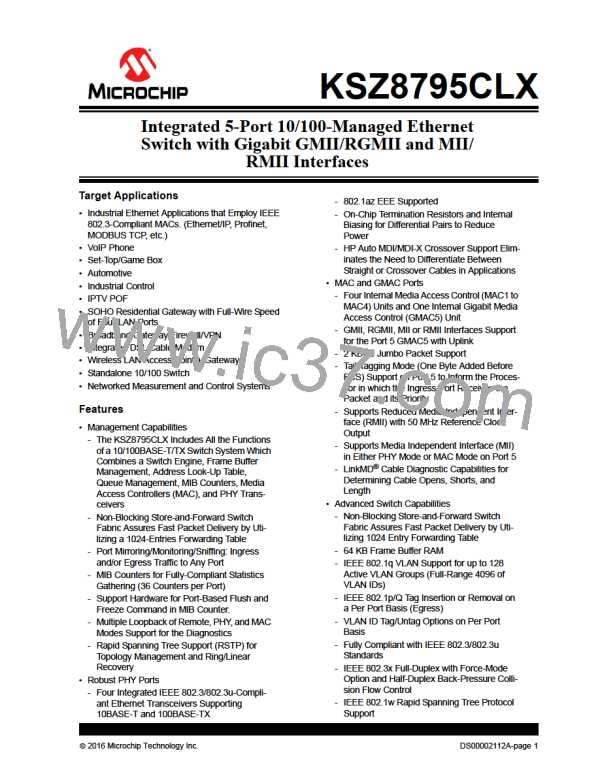KSZ8795CLX
For MLD snooping, tail tag mode also needs to be enabled, so that the processor knows which port the MLD packet was
received on. This is achieved by setting Register 12 Bit[1].
3.6.7
PORT MIRRORING SUPPORT
The KSZ8795CLX supports “port mirror” as described in the following:
3.6.7.1
“Receive Only” Mirror on a Port
All the packets received on the port will be mirrored on the sniffer port. For example, Port 1 is programmed to be “RX
sniff,” and Port 5 is programmed to be the “sniffer port”. A packet, received on Port 1, is destined to Port 4 after the
internal look-up. The KSZ8795CLX will forward the packet to both Port 4 and Port 5. KSZ8795CLX can optionally for-
ward even “bad” received packets to Port 5.
3.6.7.2
“Transmit Only” Mirror on a Port
All the packets transmitted on the port will be mirrored on the Sniffer Port. For example, Port 1 is programmed to be “TX
sniff,” and Port 5 is programmed to be the “sniffer port”. A packet, received on any of the Ports, is destined to Port 1 after
the internal look-up. The KSZ8795CLX will forward the packet to both Ports 1 and 5.
3.6.7.3
“Receive and Transmit” Mirror on Two Ports
All the packets received on Port A and transmitted on Port B will be mirrored on the sniffer port. To turn on the “AND”
feature, set Register 5 bit[0] to Bit[1]. For example, Port 1 is programmed to be “RX sniff,” Port 2 is programmed to be
“TX sniff,” and Port 5 is programmed to be the “sniffer port”. A packet, received on Port 1, is destined to Port 4 after the
internal look-up. The KSZ8795CLX will forward the packet to Port 4 only because it does not meet the “AND” condition.
A packet, received on Port 1, is destined to Port 2 after the internal look-up. The KSZ8795CLX will forward the packet
to both Port 2 and Port 5.
Multiple ports can be selected to be “RX sniffed” or “TX sniffed.” Any port can be selected to be the “sniffer port.” All
these per port features can be selected through the Port Control 1 Register.
3.6.8
VLAN SUPPORT
The KSZ8795CLX supports 128 active VLANs and 4096 possible VIDs specified in IEEE 802.1q. The KSZ8795CLX
provides a 128-entry VLAN table, which correspond to 4096 possible VIDs and converts to FID (7 bits) for address look-
up max 128 active VLANs. If a non-tagged or null-VID-tagged packet is received, then the ingress port VID is used for
look-up when 802.1q is enabled by the global Register 5 control 3 Bit[7]. In the VLAN mode, the look-up process starts
from VLAN table look-up to determine whether the VID is valid. If the VID is not valid, the packet will then be dropped
and its address will not be learned. If the VID is valid, FID is retrieved for further look-up by the static MAC table or
dynamic MAC table. FID+DA is used to determine the destination port.
Table 3-16 describes the different actions in different situations of DA and FID+DA in the static MAC table and dynamic
MAC table after the VLAN table finishes a look-up action. FID+SA is used for learning purposes. Table 3-17 also
describes learning in the dynamic MAC table when the VLAN table has done a look-up in the static MAC table without
a valid entry.
TABLE 3-16: FID+DA LOOK-UP IN VLAN MODE
DA Found in
Static MAC
Table?
FID+DA Found in
Dynamic MAC Action
Table?
Use FID Flag?
FID Match?
No
Don’t Care
Don’t Care
Don’t Care
Don’t Care
No
Broadcast to the membership ports
defined in the VLAN Table Bits[11:7].
No
Yes
Send to the destination port defined in
the Dynamic MAC Address Table
Bits[58:56].
Yes
Yes
0
1
Don’t Care
No
Don’t Care
No
Send to the destination port(s) defined
in the Static MAC Address Table
Bits[52:48].
Broadcast to the membership ports
defined in the VLAN Table Bits[11:7].
DS00002112A-page 38
2016 Microchip Technology Inc.

 MICREL [ MICREL SEMICONDUCTOR ]
MICREL [ MICREL SEMICONDUCTOR ]